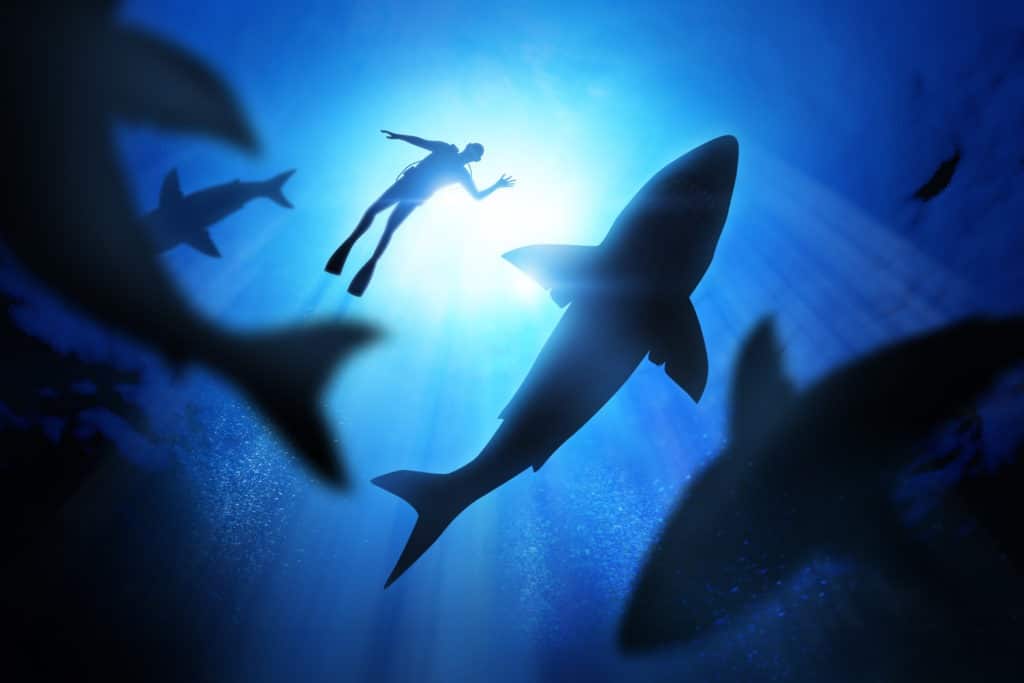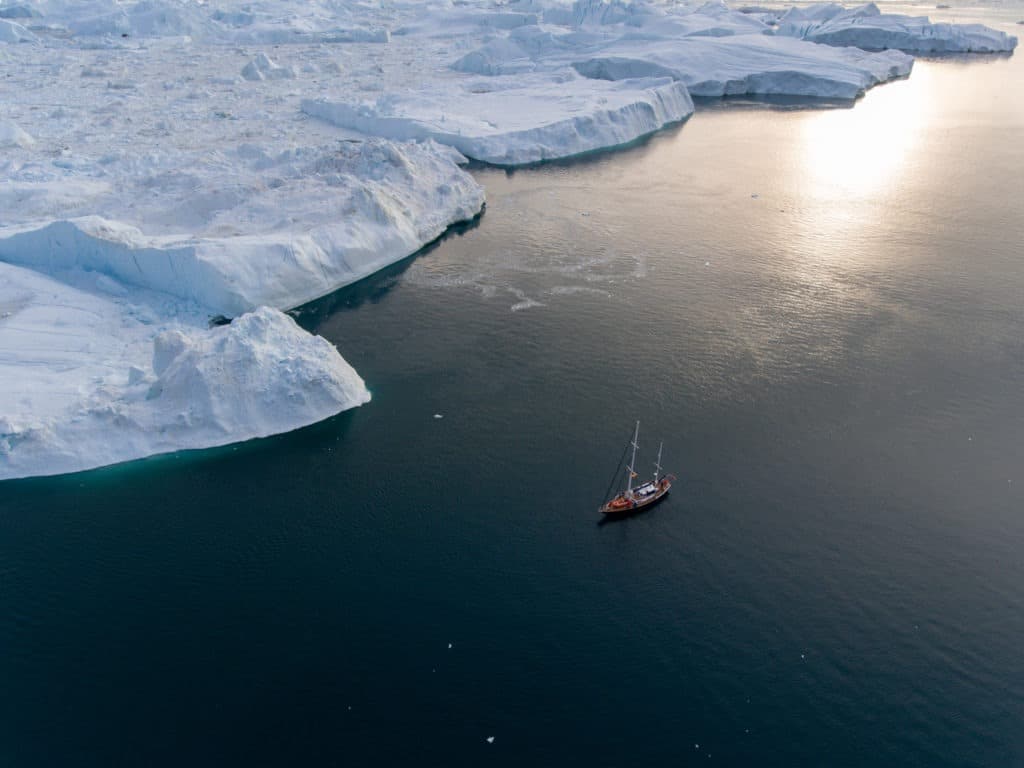Here’s whether there were sharks when the Titanic sank:
Sharks may have been in the ocean when the Titanic sank, but none of the survivors reported seeing them.
Sharks are very sensitive to sounds and vibrations. Sometimes they move closer to investigate, sometimes they flee.
If you want to learn all about the appearance of sharks when the Titanic sank, then you’re in the right place.
Let’s get started!
Were There Sharks When the Titanic Sank?
Theoretically, there could have been sharks in the ocean when the Titanic sank, but none of the survivors reported seeing them.
Sharks are very sensitive to sounds and vibrations. They sometimes move closer to investigate and other times turn to flee.
The ruckus produced by the ship crashing into the iceberg would have been sensed by the majority of marine life for miles away.
One animal that’s unafraid to inspect anything is the orca, also known as the “killer whale.” They live in all oceans and most water temperatures.
There isn’t any evidence that Orca Whales were at the disaster site. If there were orcas present, then sharks wouldn’t have been there because sharks won’t go near orcas, which are their predators.
Were There Shark-Related Incidents When the Titanic Sank?
There were no known shark attacks on Titanic survivors. None of the survivors reported shark-related incidents.

However, we have to consider the fact that the people responsible for the lifeboats kept the survivors away from the people in the water. If the lifeboat personnel were far away, they could have missed seeing a shark attack.
Only the people in the water could have been shark victims. A shark won’t attack a boat. It might, at most, give it a bump to test it.
The people rescued from the water were hypothermic.
It’s possible that while being in the water in nearly comatose states, they didn’t notice other people being dragged under. Even if they saw such horrors, they might not have remembered them later because of their trauma.
None of the corpses pulled from the water showed any signs of shark bites on them. However, most of the corpses were never found.
Low Impact Attacks
If any attacks occurred, they were low-impact attacks by Greenland sharks. These sharks have black coloration and move very slowly, so it would be hard to notice them even though they are as big as great white sharks.

Low-impact attacks mean that the shark will get close to a target and bump it. If there is no response (the target is dead or unconscious), the shark will drag the body under. But if the target kicks back, the shark will swim away.
Were There Any Shark-Attack Survivors From the Titanic?
No survivors of the Titanic claimed to be attacked by a shark. There is no evidence of sharks attacking people in the water after the ship sank.
Sharks Don’t Like Human Flesh
If a shark bites a human, it’s only to test whether the prey suits its taste. Sharks usually discontinue their attacks on humans because they didn’t like the way humans taste.
The only shark species that likes human flesh is the bull shark. It lives in areas of the Atlantic Ocean stretching from Massachusetts to southern Brazil.
Scavenging Corpses
The only likely scenario where sharks may have mutilated victims of the Titanic is one in which they scavenged corpses from the seabed. The Titanic sank in Greenland shark habitat, and Greenland sharks are a completely opportunistic shark species.

Such a plentitude of dead bodies in the water would draw sharks from miles away.
The longest living animal on the planet, Greenland sharks can reach 400 years of age. If the scavenging scenario is true, there are probably still living Greenland sharks that fed on Titanic victims stranded in the Atlantic Ocean.
Cases of Shark Attacks After a Shipwreck
The most famous case of shark attacks following a shipwreck is the 1945 Indianapolis incident. The Indianapolis was a United States naval ship sunk by the Japanese during World War II.
After being hit by two submarine torpedoes, the Indianapolis sunk in the Pacific Ocean in just 12 minutes. Of the 1196 people on board, only 900 made it alive into the water. What they thought was their lucky day was just the beginning of the worst shark nightmare in history.
As time passed, the survivors formed groups and held onto objects and bobbing corpses to stay afloat. The explosion and the blood in the water drew many shark species, among which was the aggressive species known as the oceanic whitetip shark.

The sharks were mainly focused on the floating dead, but there were also survivors with open wounds that attracted more of the predators. When the sailors noticed someone was injured or bleeding, they tried to quarantine themselves and swim away.
Survivors pushed the dead away as a form of sacrifice. One group of sailors made the mistake of opening a can of Spam. The strong scent of meat drew the predators nearer, so the sailors threw the Spam away to avoid being swarmed.
The sharks fed on the dead for days while the survivors watched helplessly.
Most of the people were paralyzed by fear that went on for days because there wasn’t any sign of a rescue. Many people died out of thirst or sat poisoning when they succumbed to thirst and drank seawater.
After 4 days, only 317 survivors were left to be rescued. Between 50 and 150 people died as a result of shark attacks.
There’s no way to know the exact number of victims, but the Indianapolis remains one of the most horrific shark-related incidents in history.
Where Was the Titanic Going?
The Titanic was on its maiden voyage from Southampton (England) to New York City (USA). The ship set sail on April 10, 1912, and first arrived at Cherbourg docks in France. The last European stop was Queenstown, Ireland. On the afternoon of April 11, the ship headed toward the new continent.

Four days later, the expensive British liner sank in the North Atlantic Ocean. It was approximately 400 miles off the coast of Canada, and Newfoundland was the closest town.
What Shark Species Live In The Atlantic Ocean?
The US eastern coastal waters are home to more than 50 species of sharks. The size of the sharks varies from very small dogfish to enormous great white sharks.
The Great White Shark
The most feared predator to swim the North Atlantic Ocean is the great white shark. These animals are fast, strong, and potentially aggressive. On the night of the Titanic’s crash, there’s a tiny possibility that there were some great whites in the waters.

The reason that the chance was tiny was the temperature of the water. Great white sharks mostly enjoy swimming in waters with temperatures between 54 and 75 0F (12-24 0C). The temperature of the water when the Titanic sank was -2.2 0C.
The Northeast coast of the United States, along with Californian coastal waters on the southwestern coast, has a greater concentration of great white sharks than any other coastal waters.
The Greenland Shark
At the time of the Titanic disaster, the most probable shark species to dwell in the freezing North Atlantic waters was the Greenland Shark. These sharks don’t mind being in the cold. You can even find them swimming under Arctic ice packs.

The Greenland shark prefers calm nights. Under such circumstances, they come near the surface. One of the reasons the Titanic crew didn’t notice the iceberg soon enough was that the ocean was particularly calm on the night of the crash.
Only two Atlantic Ocean shark species can tolerate cold water:
- Greenland shark
- Black dogfish shark
Black Dogfish Shark
The black dogfish shark is a scavenger and an opportunist. It feeds on bony fishes, squids, octopuses, crabs, lobsters, shrimp, etcetera. The average black dogfish shark is 24-30 inches (60-75 cm) long, but some can grow up to 3.6 ft (1.1 meters).
Black dogfish sharks are completely harmless to humans. There has never been a reported incident of a human being attacked by this species. However, the possibility of scavenging human corpses in the water when there is a shortage of other food remains.
Are There Many Sharks in North Atlantic Ocean in April?
There are sharks in the North Atlantic Ocean throughout the year.
In April, the month when the Titanic sank, there are usually fewer sharks in the north, especially in the open ocean, because of low water temperatures.
In Which Ocean Did Most Shark Attacks Happen?
The incidence of shark attacks in the Atlantic Ocean is higher than in other oceans. The reason for the higher incidence is probably the different strength and size of the Atlantic shark species.

Most of the shark attacks in the Atlantic are by smaller sharks like the blacktip. Some of the currents such as the Gulf Stream can bring warm waters near shore. These waters have baitfish to which the sharks are attracted.
Most cases of bites in the Atlantic Ocean are minor and insignificant. They generally happen in warmer months because that’s the time when there are more people in the water, either swimming or surfing.
If you compare the number of shark attacks on humans in the North Atlantic Ocean and the South Atlantic Ocean, the chances of getting bitten in the southern part are much higher.
